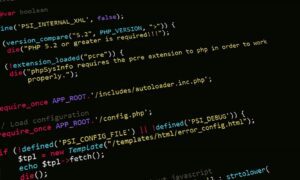Data. This word contains numerous meanings and trillions of dollars for the world’s economy. It’s hardly possible to find a business that doesn’t utilize data for analysis, predictions, planning, and so on. Clients’ information is vital for marketers that design promotional strategies and personalized offers using profiles of buyers and/or leads. Without data, both small online shops and giant corporations couldn’t reach the required profitability and recognition.
Wherein, data is dangerous. Just imagine tons of sensitive info such as emails, phones, street addresses, bank account numbers, and even passwords that are stored online in potentially vulnerable databases. As well, imagine temptations of rulers who own these digital goldmines. The most recent scandal related to data leaks hit Facebook in 2018. The company sold users’ private data without their consent and eventually lost $120 billion in market cap.
Facebook’s way of getting value from data is a dead end. Instead, it’s possible to maximize benefits legally and transparently thanks to modern technologies and strategies. Further, we will cover the key benefits of Big Data, predictive analysis, and innovative approaches to information processing.
Data Science in a Nutshell
Basically, data science is a complex field consisting of processes and methods focused on getting valuable knowledge from different types of data, including raw and structured ones. With techniques borrowed from mathematics, statistics, and informatics, data science tries to analyze various information and increase its value, particularly but not exclusively, for businesses.
Berkeley School of Information lists five stages of the modern lifecycle of data:
- Capture: acquire, input, extract.
- Maintain: store, cleanse, structure.
- Process: mine, classify, model, summarize.
- Analyze: explore, confirm, predict.
- Communicate: report, visualize, make decisions.
In recent years, the science focuses on two major trends: Big Data (put simply, extremely large packages of information that can be processed by specific software and can generate new value) and machine learning (an approach that gives computers only the basic algorithms and forces them to modernize independently using existing data).
The following info will be focused on Big Data, mainly, because this approach is almost obligatory for modern companies that want to improve data value. However, it’s strongly connected with machine learning and various types of analysis so we will keep them in mind, too.
Big Data Benefits for Businesses
Generally, all types of data can generate direct or indirect profits for companies. When it comes to Big Data, both models feature even more advantages. It’s simple as more data means more opportunities to earn with it, either by selling to partners or improving business processes. Let’s check two benefits’ models now:
- Direct. Selling collected data to customers or third parties. Of course, companies must get users’ consent before delivering their personal information to other firms.
- Indirect. Improving business operations using analyzed data, e.g. predicting future clients’ requests. In this case, brands also must notify customers that they collect info.
When the first approach is pretty straightforward, the second one covers several not as obvious benefits for entrepreneurs. Find three definitive Big Data strengths below.
1. Comprehensive Understanding
The more information you have the more complete picture you can get. This rule is valid for in-house processes, customers, and the entire market. With Big Data, it’s possible to collect valuable insights much quicker than it was performed during traditional data science eras. Now, analytics can gather info within hours and even minutes to define customers’ needs, marketers’ performance, and global market changes in real time.
A challenge: make sure that you collect only useful data that has value for the company.
2. Accurate Predictions
Modern data science stands not only for volume but for accuracy, as well. If earlier companies had to rely on limited information, now they can process much wider selection with better precision. Using predictive analysis tools, managers are able to forecast the future needs of clients based on their current behavior. AI platforms are smart enough to tell which products or services people will want today and tomorrow.
A challenge: check the predictions and have human analytical opinions in addition to AI.
3. Cost and Time Savings
Concluding two previous points, we see that Big Data and predictive analysis are wonderful tools for cost-efficient management. Thanks to them, businesses can automate mundane operations, focus on useful insights, and develop more profitable strategies. Machine learning and robotic processes deliver quick decisions based on giant arrays of data processes in a wink. Moreover, a better understanding of customers allows for increasing profits greatly.
A challenge: calculate expenses on Big Data and BI processes to get positive ROI.
Tips on Maximizing Value of Your Data Analysis
With an understanding of Big Data usefulness, we can proceed to ways in which you can get the most profits out of available information. Needless to say that having a skilled team of data engineers that work with modern powerful software is required. But here are a few suggestions on optimizing processes of data analyzing and usage:
- Cleanse data. This will improve accuracy and reduce errors.
- Consolidate data. To avoid silos, you want to get a single database.
- Plan access levels. They will keep the balance between security and efficiency.
- Be scalable. New data will come so you want to have enough space.
- Acquire third-party data. Work with other firms to get even more insights.
- Study customers. Utilize data to learn about the target audience, firstly.
Top Data Science Trends for 2019
In conclusion, we’d like to present the most intriguing trends that emerge in data science right now. Most likely, they will define the whole industry’s development this year. By exploring these trends, businessmen and managers can prepare for new changes and invest in profitable solutions to get an advantage over competitors:
- AI-as-a-Service (AIaaS). A lot of companies already have wide access to cloud services that focus on AI computations and development. Generally, AIaaS allows various teams to work with AI platforms without investing in own in-house projects. Right now, corporations like Google, Microsoft, and Amazon deliver cloud AI solutions.
- AutoML and Auto-Keras. Earlier, professional machine learning and advanced data science operations were available to large universities or tech giants only. AutoML makes machine learning automated and accessible for common users. With open source tool called Auto-Keras, researchers even don’t have to pay for this service.
- DataOps. Being a child of data analysis and DevOps engineering, DataOps is a methodology focused on utilizing best practices from development and analytics to create and support data pipelines more efficiently. In 2018, Nexla found that 73% of brands are going to invest in DataOps to improve data science lifecycle.
- Edge computing. The new technology that may replace already traditional clouds. According to edge computing idea, data is gathered, stored, and processed at end devices such as IoT gadgets, drones, self-driving cars, etc. This approach decentralizes information and makes the global ecosystem of Big Data more scalable.
- Reinforcement learning (RL). A type of machine learning that stands for the interaction of programs aka agents with an environment. In this case, machines learn which actions bring reward and how to maximize benefits. The best example of RL success is the victory of OpenAI Five over humans in Dota 2.
Surely, the world of data evolves quickly so nobody can guarantee that the mentioned changes will become new standards. However, innovations often attract clients that want to get something unusual and new. Be sure to research each field or trend before investing in it but also be aware of top outsourcing countries that develop innovative data science strategies.
Good luck and remember that data is one of the most precious resources right now!



















































